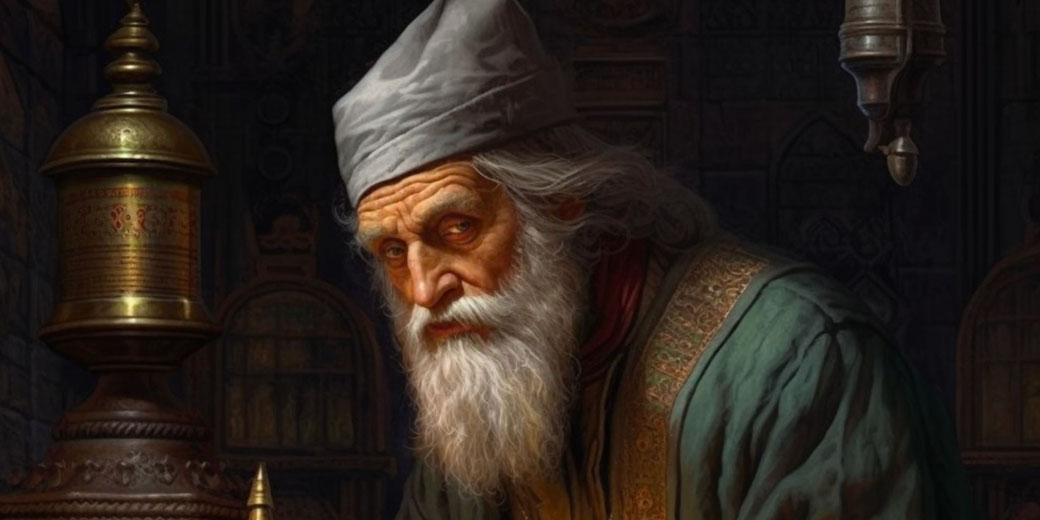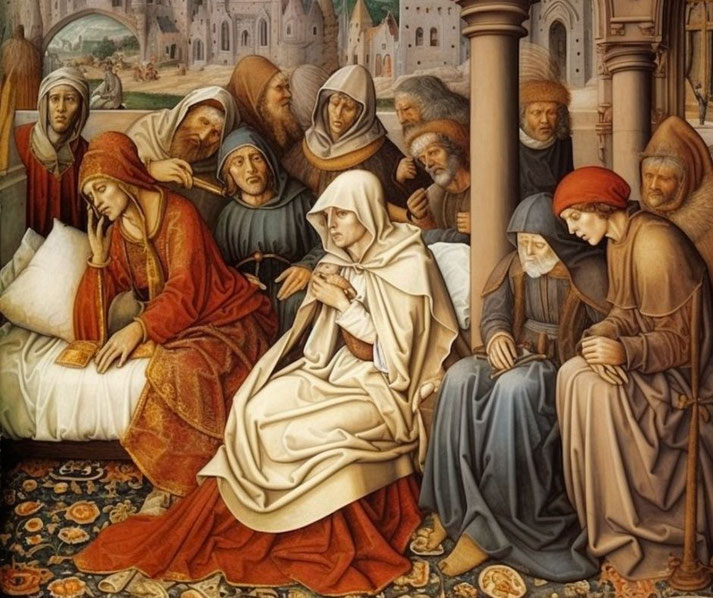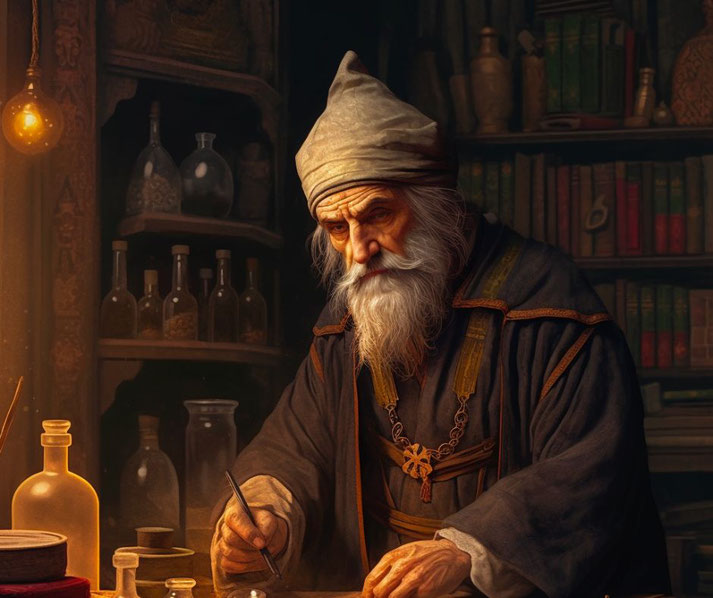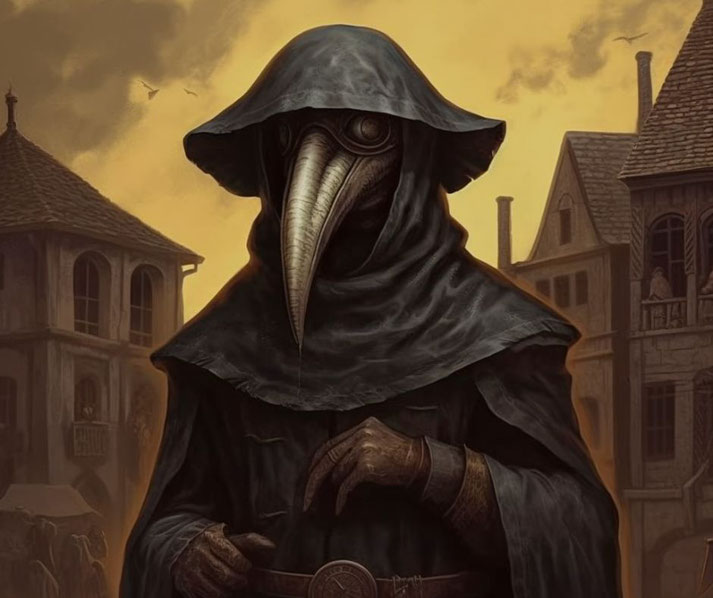From leeches to barber-surgeons: The deadly world of medieval medicine

An era characterized by a fascinating blend of superstition, religion, and empirical observations, the Middle Ages introduced a unique approach to healing that laid the groundwork for the advancement of modern healthcare.
Disease was a mysterious and often terrifying reality for medieval people. Without the knowledge of germs, illnesses were attributed to a variety of causes – an imbalance of the four humors, divine punishment, or the influence of the stars.
Treatments were equally varied, from bloodletting and purges to herbal remedies and prayer.
Even though some of the practices seem crude or superstitious to modern sensibilities, it is critical to understand that medieval medicine developed within a specific historical and cultural context.
These were times of plagues and rampant diseases, yet they also marked the beginnings of systematic medical education, the growth of hospitals, and a nascent understanding of anatomy, surgery, and pharmacology.
The world of the Middle Ages
The Middle Ages, also known as the medieval period, is a time in European history spanning from the 5th to the 15th century.
It began with the fall of the Western Roman Empire in AD 476 and ended around the time of the discovery of the New World by Christopher Columbus in 1492 and the start of the Protestant Reformation in 1517.
This era is traditionally divided into three periods: the Early Middle Ages (5th to 10th centuries), the High Middle Ages (11th to 13th centuries), and the Late Middle Ages (14th to 15th centuries).
The Middle Ages are characterized by significant changes in all spheres of life. It was a period of political and social transformation, with the collapse of the Roman imperial system giving rise to various forms of governance, notably feudalism.
The Catholic Church also rose to prominence, playing a crucial role in societal structure, politics, education, and culture.
Despite often being portrayed as a time of stagnation or decline following the grandeur of the Roman Empire, the Middle Ages was a period of significant development and innovation.
It saw the establishment of universities, the development of scholastic philosophy, advances in science and medicine, and the formation of early forms of representative government, particularly in England with the Magna Carta and the establishment of the Parliament.
In particular, it was a time when medical practices were as much an art as they were a science.
Rooted in the philosophies of ancient scholars like Hippocrates and Galen, it was a period when the understanding of the human body was limited, yet the desire to heal was immense.

Medieval medical theory: The Four Humors
In the realm of medieval medicine, the theory of humorism reigned supreme. This approach to health and disease, initially proposed by Hippocrates and later refined by Galen, was the cornerstone of medical understanding throughout the Middle Ages.
The theory was centered around the idea that the human body contained four "humors" or fluids: blood, phlegm, yellow bile, and black bile.
These were thought to correspond to the four elements—fire, earth, air, and water—and the four seasons.
Blood, linked with air and spring, was associated with a sanguine personality—optimistic and active.
Phlegm, corresponding to water and winter, was tied to a phlegmatic temperament—relaxed and peaceful.
Yellow bile, connected to fire and summer, was associated with a choleric personality—short-tempered and irritable.
Lastly, black bile, linked to earth and autumn, was related to a melancholic disposition—introspective and thoughtful.
The theory proposed that a balance of these humors was necessary for good health, and any deviation from this equilibrium led to illness.
For example, an excess of black bile was believed to cause melancholy, while an overabundance of yellow bile could lead to anger and restlessness.
The humoral theory also informed the practice of dietetics in medieval medicine, as certain foods were believed to increase or decrease specific humors.
For instance, wine was thought to stimulate the production of blood, while vinegar was believed to decrease it.
Humorism extended beyond just physical health and was used to explain mental conditions, personality traits, and even moral qualities.
It offered a comprehensive, albeit flawed, understanding of human health, physiology, and psychology.
It shaped the diagnostic and therapeutic approaches of medieval physicians, leading to treatments like bloodletting and purging to 'balance' the humors.
Intriguingly, despite its inaccuracy by modern standards, the theory of humorism had a profound and lasting impact on medical practice.
Its influence was not limited to the Middle Ages but extended into the Renaissance and even the Early Modern period.
It also left a mark on language, with words like "melancholic" and "sanguine" still used today to describe certain moods or dispositions.
The crucial role of the Church in healthcare
The role of religion in the daily life and thought of the medieval era was profoundly influential, and medicine was no exception.
Christianity, in particular, played an integral role in the development and delivery of healthcare during the Middle Ages.
The Church acted as both a guardian and a disseminator of medical knowledge during this period.
Many ancient medical texts were preserved in monastic libraries, and it was often monks who copied these texts, ensuring their survival.
Monasteries often served as centers for healing, with monks providing care for the sick, the poor, and the elderly within their communities.
They cultivated medicinal plants in their gardens, prepared remedies, and acted as a primitive form of healthcare system in a time when no such system existed.
The monastic infirmary was a precursor to the hospital, providing a place of refuge and care for those suffering from various ailments.
Medical practices were also deeply intertwined with religious beliefs. The theory of humorism was often interpreted in light of Christian theology.
The four humors were linked to the four elements, the four cardinal virtues, and the four evangelists, providing a medical philosophy that was in harmony with the religious worldview of the time.
Disease was often seen as a spiritual as well as a physical ailment, with sin seen as a potential cause of illness.
As such, religious rites and prayer often accompanied medical treatment.
Pilgrimages to shrines of saints reputed to have healing powers were a common practice for those seeking relief from disease.
At the same time, the Church's authority also had a restricting effect on the development of medicine.
Certain practices, such as dissection of human bodies, were often prohibited or frowned upon, which limited anatomical understanding.
The Church also sometimes deemed certain medical procedures or theories as heretical, limiting the progress of medical knowledge.
However, despite these constraints, the Church also promoted the advancement of medical knowledge.
It founded and supported many of the earliest universities where medicine was taught, and it was a papal decree in the 13th century that required physicians to be formally educated.
How did people learn medicine in the Middle Ages?
Early in the medieval period, medical knowledge was often passed down through apprenticeships.
Individuals seeking to practice medicine typically trained under a skilled physician, learning through observation and hands-on experience.
However, this was a time-consuming process, often requiring many years of dedication.
As the medieval period progressed, the monastic and cathedral schools, which initially focused on theological studies, began to incorporate more secular subjects, including medicine, into their curricula.
The health of monks and other religious figures had always been a concern, and as such, rudimentary medical education was provided to ensure care within religious communities.
The 12th and 13th centuries saw a significant shift in medical education with the rise of universities. Medical schools began to emerge in cities like Salerno, Montpellier, Bologna, and Paris.
The School of Salerno, in particular, is often considered the first medical school and is known for the famous medical text, "Regimen Sanitatis Salernitanum," also known as the "Salerno Health Guide."
These early medical universities aimed to provide a more formalized and systematic approach to medical training.
They based their curriculum on ancient Greek and Roman medical texts, predominantly the works of Hippocrates and Galen, which were translated into Latin.
Students would spend years studying these texts, along with philosophy and theology, before moving on to more practical training.
Although theoretical training was emphasized, practical experience was also a key component of medical education.
This was often obtained at hospitals that were associated with the universities.
The hospital of Santa Maria Nuova in Florence, for instance, was renowned for its role in the practical training of physicians.
Moreover, the Church played a significant role in the standardization of medical education.
A papal decree in the 13th century necessitated that physicians be trained at a university, leading to more rigorous and formalized training.
It's important to note, however, that women and individuals of lower social classes often faced barriers to this formal education.
While there are notable exceptions, such as Trotula de Ruggiero from the School of Salerno, who is considered one of the first female physicians, access to medical education was typically restricted to men.

Who were considered 'doctors'?
Medieval healthcare was a complex blend of learned medicine, folk remedies, religious beliefs, and community care.
At the top of the healthcare pyramid were the physicians, formally educated individuals who had studied at universities.
Their practice was based on the theories of ancient scholars like Hippocrates and Galen, and they provided care primarily for the nobility and the upper classes.
Their treatments included dietary advice, bloodletting, and the prescription of various concoctions to balance the humors.
However, the majority of the population did not have access to these learned physicians.
Instead, they relied on local healers, midwives, herbalists, and apothecaries for their healthcare needs.
These practitioners, although often lacking formal education, possessed a wealth of practical knowledge about local plants, home remedies, and traditional healing practices.
They played a crucial role in providing care for their communities.
Religion was also deeply intertwined with healthcare. The Church not only influenced medical theory but also provided practical care for the sick and the needy.
Monastic infirmaries offered care to the monks and often to the local community. Later, more specialized establishments evolved - the medieval hospitals.
The hospitals of the Middle Ages were not like the institutions we know today. They were often founded by religious orders or charitable individuals and primarily served to provide care for the poor, the old, the infirm, and the traveler.
They offered food, shelter, and basic medical care. Major cities, like London, Paris, and Florence, had hospitals, some of which evolved into today's modern healthcare facilities.
The role of hospitals expanded during times of epidemics, like the Black Death. These were times of extreme crisis when the healthcare infrastructure was pushed to its limits.
Such epidemics spurred the development of new forms of healthcare institutions, like pesthouses, which were specialized facilities for plague victims.
While the healthcare system in the Middle Ages was rudimentary by today's standards, it represented a society's effort to care for its sick and ailing.
From the learned physicians and their humoral theories to the monastic infirmaries and folk healers, healthcare was as multifaceted as the society itself.
Common medieval diseases and treatments
Disease was a constant companion to medieval society. The period was riddled with various ailments, from leprosy and tuberculosis to dysentery and the common cold.
However, the most notable and devastating disease was the bubonic plague, also known as the Black Death, which swept through Europe in the 14th century, killing an estimated one-third of the population.
The causes of diseases were not understood as we understand them today.
Without the knowledge of germs or the role of sanitation and hygiene, medieval people attributed illnesses to various sources, including supernatural elements, miasma (bad air), astrological influences, and the imbalance of the four humors.
This lack of understanding led to a variety of treatments, often more harmful than the diseases themselves.
Bloodletting, a common treatment based on the theory of humors, was employed to rebalance the body's humors by removing 'excess' blood. Leeches were used for the same purpose.
Purging, either through emetics or laxatives, was also a common practice.
Herbal remedies played a significant role in medieval medicine. Plants, herbs, and spices were used for their perceived medicinal properties.
Some, like willow bark (a natural source of salicylates, which are similar to the active ingredient in aspirin), did have actual therapeutic effects.
Religious and spiritual treatments were also common. Prayer, holy water, relics, and pilgrimages to holy sites were all employed in hopes of divine intervention.
Saints were often invoked for specific ailments, such as St. Anthony for ergotism (St. Anthony's Fire) or St. Apollonia for toothaches.
Surgery, while less common due to the risks of infection and the lack of anesthesia, was still practiced in certain cases.
The removal of cataracts, treatment of fractures, and even some forms of brain surgery were performed by skilled surgeons.
The most drastic measure taken during times of epidemic was quarantine. During the Black Death, for example, ships were often isolated for a period of forty days, giving us the term 'quarantine' from the Italian 'quaranta giorni,' meaning 'forty days.'

How the Middle Ages influenced modern medicine
First and foremost, the Middle Ages witnessed the establishment of the first universities and medical schools, such as those in Salerno, Bologna, and Paris.
These institutions not only helped preserve and disseminate ancient medical knowledge but also pioneered the systematic training of physicians, a practice that continues to this day.
The period also saw the foundation of hospitals as we know them. Initially created as places of hospitality and care for the sick, the poor, and travelers, they eventually evolved into centers of medical treatment and learning.
The concept of the hospital as a place where the needy can receive care remains central to our modern healthcare system.
Medieval medicine also left its mark on our understanding of public health. The devastating impact of the plague led to the implementation of public health measures, such as quarantine and the isolation of the sick, which are still critical in managing disease outbreaks today.
The era’s influence is also seen in the herbal remedies and surgical techniques it developed.
Many plants first used in medieval times continue to be explored for their medicinal properties.
Moreover, while medieval surgery was basic, it paved the way for the development of the field.
Furthermore, the integration of spiritual and physical care in medieval medicine echoes in today's growing understanding of the need for holistic care.
The recognition that health is not merely the absence of disease, but a state of complete physical, mental, and social well-being, resonates with the medieval approach to healing.
However, the legacy of medieval medicine is not just in its successes and advancements, but also in its failures and misconceptions.
The shortcomings of humoral theory, the lack of knowledge about hygiene and disease transmission, and the often harmful treatments all serve as reminders of how far we have come.
They highlight the importance of scientific inquiry, evidence-based practice, and continuous learning in the pursuit of health.
What do you need help with?
Download ready-to-use digital learning resources
Copyright © History Skills 2014-2024.
Contact via email
With the exception of links to external sites, some historical sources and extracts from specific publications, all content on this website is copyrighted by History Skills. This content may not be copied, republished or redistributed without written permission from the website creator. Please use the Contact page to obtain relevant permission.





